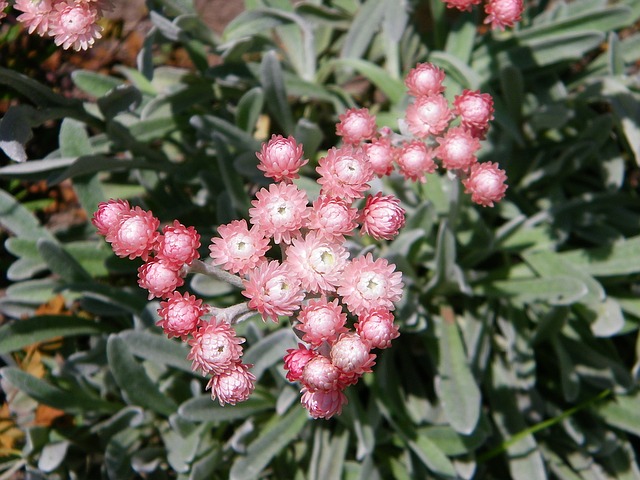 |  |  |  |  |
 |  |
Mountain Everlasting is a perennial plant. The plant has a thin, horizontal, creeping, woody rhizome with many fine roots. The erect, simple, white, velvety flower stems grow up to 30 cm and are more often single, rarely multiple stems grow.
The many shoots of the Mountain Everlasting form turfs on which the rosette leaves are arranged. Root leaves are dull, spade-shaped, bare, green on top, white-velvety on the bottom. Grows up to 50mm long, 10mm wide. Leaves narrow at the base. The plant has 5-10 leaves on the stem. They are white velvety on both sides, sessile, pressed to the stem, elongated lanceolate or linear, with a pointed tip.
There are 3-15 flower baskets on Mountain Everlasting , they are placed on white hairy, short flower stalks, which reach 6 mm in diameter. The flowers are arranged in baskets. Petals can be of different colors - female from soft pink to bright red, male - white. On the bottom, the baskets are light green. Fruit - a testicle with a matcap. Blooms in May and June.
For medicinal purposes, the above-ground part of the plant is used, in pharmacies it is called Herba Antennariae dioicae and the flower baskets of the plant Flores Antannariae dioicae. The above-ground part of the plant is harvested during its flowering period from May to July.
It is important to harvest the plant until the flower boxes have fully opened, but they must be fully formed. It is not worth collecting flower boxes that have not yet formed, because they are useless for treatment, and the same is true if they are collected too late, as the flower boxes dry, the petals begin to fall off. The collected above-ground part of the plant is dried in a well-ventilated, shady place.
From a chemical point of view, the plant has been studied relatively little. On the other hand, studies have determined that the plant contains saponins and phytosterols, tannins, bitter substances and resins, as well as vitamin K, C, octacosane, phylloquinone and essential oil.Medicinal significance
The Mountain Everlasting was studied in Russia, at the Sverdlovsk Medical Institute. As a result of research, it was found that the plant has antispasmodic and choleretic properties. Its use is effective in the case of pronounced gallbladder dysfunction and bile reflux path disorders, especially if hypertonic form of dyskinesia or chronic cystitis is also present.
The anti-bleeding properties are explained by tannins and vitamin K present in the plant. In terms of its ability to stop bleeding, Mountain Everlasting is more effective than calcium chloride preparations and adrenaline.
Mountain Everlasting has also found its use in folk medicine. Roots of the plant or its pods are used orally to stop internal bleeding - in the digestive tract and lungs. Externally, the poultice is used to keep nasal congestion, bleeding gums, bleeding wounds, eczema, jaundice and children's diathesis.
Compresses are applied to abscesses, bruises, tumors, thickening of mammary glands, as well as in case of eye diseases - glaucoma and cataracts.
An ointment is prepared on the basis of a Mountain Everlasting , which is effective in furunculosis and wound healing. Open wounds can also be covered with the powder of this plant.
Mountain Everlasting is also used to stop uterine bleeding, treat menstrual disorders and leucorrhoea. For this purpose, baths are prepared by adding decoctions of the plant to them - they will also be effective in case of hemorrhoidal bleeding.
Gallbladder and liver diseases are also treated with the decoction, it is recommended to use the decoction for people with high blood pressure, as a sedative and mild sleep-inducing agent.
